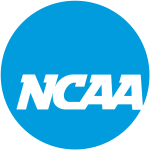 | |
 NCAA's national office in Indianapolis | |
| Abbreviation | NCAA |
|---|---|
| Founded | March 31, 1906 in New York City, U.S.[a] |
| Legal status | Association |
| Headquarters | Indianapolis, Indiana, U.S. |
Region served | United States and one institution in Canada[2] |
Membership | About 1,100 schools[3] |
President | Charlie Baker |
Main organ | Board of Governors |
| Website | |
| NCAA divisions |
|---|
The National Collegiate Athletic Association (NCAA)[b] is a nonprofit organization that regulates student athletics among about 1,100 schools in the United States, and one in Canada.[3] It also organizes the athletic programs of colleges and helps over 500,000 college student athletes who compete annually in college sports.[3] The headquarters is located in Indianapolis, Indiana.
Until 1957, the NCAA was a single division for all schools. That year, the NCAA split into the University Division and the College Division.[4] In August 1973, the current three-division system of Division I, Division II, and Division III was adopted by the NCAA membership in a special convention. Under NCAA rules, Division I and Division II schools can offer scholarships to athletes for playing a sport. Division III schools may not offer any athletic scholarships. Generally, larger schools compete in Division I and smaller schools in II and III. Division I football was further divided into I-A and I-AA in 1978, while Division I programs that did not have football teams were known as I-AAA. In 2006, Divisions I-A and I-AA were, respectively, renamed the Football Bowl Subdivision (FBS) and Football Championship Subdivision (FCS). In its 2022–23 fiscal year, the NCAA generated $1.28 billion in revenue, $945 million (74%) of which came from airing rights to the Division I men's basketball tournament.[5]
Controversially, the NCAA substantially restricts the kinds of benefits and compensation (including paid salary) that collegiate athletes could receive from their schools. The consensus among economists is these caps for men's basketball and football players benefit the athletes' schools (through rent-seeking) at the expense of the athletes.[6][7][8] Economists have subsequently characterized the NCAA as a cartel.[9][10][11] In 2021, the Supreme Court of the United States unanimously ruled that some of these NCAA restrictions on student athletes are in violation of US antitrust law.[12] The NCAA settled a lawsuit in May 2024 allowing member institutions to pay Division I athletes who have played since 2016.
- ^ Cite error: The named reference
ncaahistwas invoked but never defined (see the help page). - ^ "Simon Fraser University approved to join NCAA D II". Tsn.ca. October 7, 2009. Archived from the original on July 14, 2009. Retrieved November 6, 2009.
- ^ a b c "Overview". National Collegiate Athletic Association. Retrieved May 23, 2022.
- ^ "NCAA Group Opens Talks On Money Aid To Players". Kingsport Times. August 20, 1956. p. 7 – via Newspapers.com.
- ^ "NCAA records nearly $1.3B in revenue for '22-23". ESPN.com. AP. February 2, 2024. Retrieved April 22, 2024.
- ^ Cite error: The named reference
:5was invoked but never defined (see the help page). - ^ Sanderson, Allen R.; Siegfried, John J. (February 2015). "The Case for Paying College Athletes". Journal of Economic Perspectives. 29 (1): 115–138. doi:10.1257/jep.29.1.115.
- ^ Garthwaite, Craig; Keener, Jordan; Notowidigdo, Matthew J; Ozminkowski, Nicole F (October 2020). "Who Profits From Amateurism? Rent-Sharing in Modern College Sports". National Bureau of Economic Research. Working Paper Series. doi:10.3386/w27734.
- ^ Sanderson, Allen R.; Siegfried, John J. (March 1, 2018). "The National Collegiate Athletic Association Cartel: Why it Exists, How it Works, and What it Does". Review of Industrial Organization. 52 (2): 185–209. doi:10.1007/s11151-017-9590-z. ISSN 1573-7160. S2CID 86850372.
- ^ Blair, Roger D.; Whitman, Joseph (March 1, 2017). "The NCAA Cartel, Monopsonistic Restrictions, and Antitrust Policy". The Antitrust Bulletin. 62 (1): 3–14. doi:10.1177/0003603X16688836. ISSN 0003-603X. S2CID 157372084.
- ^ Humphreys, Brad R.; Ruseski, Jane E. (2009). "Monitoring Cartel Behavior and Stability: Evidence from NCAA Football". Southern Economic Journal. 75 (3): 720–735. doi:10.1002/j.2325-8012.2009.tb00928.x. ISSN 0038-4038. JSTOR 27751412. S2CID 44035483.
- ^ "High court rules against NCAA on compensation". ESPN.com. June 21, 2021. Retrieved June 21, 2021.
Cite error: There are <ref group=lower-alpha> tags or {{efn}} templates on this page, but the references will not show without a {{reflist|group=lower-alpha}} template or {{notelist}} template (see the help page).